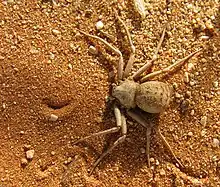Hexophthalma
Hexophthalma is a genus of spiders in the family Sicariidae.[1] Although the genus was originally erected in 1878 (then with the name Hexomma), it was merged into the genus Sicarius in the 1890s, and remained unused until revived in 2017, when it was discovered that the African species then placed in Sicarius were distinct. The English name six-eyed sand spiders is used for members of the genus,[2] particularly Hexophthalma hahni. Species in the genus have necrotic (dermonecrotic) venom, and can potentially cause serious or even life-threatening wounds.
| Hexophthalma | |
|---|---|
 | |
| Unidentified species from coastal Namibia | |
| Scientific classification | |
| Kingdom: | Animalia |
| Phylum: | Arthropoda |
| Subphylum: | Chelicerata |
| Class: | Arachnida |
| Order: | Araneae |
| Infraorder: | Araneomorphae |
| Family: | Sicariidae |
| Genus: | Hexophthalma Karsch, 1879[1] |
| Diversity[1] | |
| 8 species | |
Taxonomy
The genus was first created in 1878 by Friedrich Karsch as Hexomma, with the sole species Hexomma hahni. By 1879, though, Karsch had realized that this name had already been used in 1877 for a species of harvestman, so he published the replacement name Hexophthalma.[1] In 1893, Eugène Simon transferred Hexophthalma hahni to the genus Sicarius, and Hexophthalma fell out of use, until a phylogenetic study in 2017 showed that the African species of Sicarius, including Sicarius hahni, were distinct, and revived the genus Hexophthalma for them.[3]
Hexophthalma is one of three genera in the family Sicariidae, as of July 2018.[4] It is placed in the same subfamily, Sicariinae, as Sicarius:[3]
| Sicariidae |
| ||||||||||||
Species
Two new species were added to the genus in 2018, and one previously accepted species, H. testacea, was synonymized with H. hahnii. The number of species is expected to increase with further study. H. spatulata differs in a number of respects from other species in the genus, which thus may not be monophyletic.[2]
As of July 2018, the World Spider Catalog accepted these extant species:[1]
- Hexophthalma albospinosa (Purcell, 1908) – Namibia, South Africa
- Hexophthalma binfordae Lotz, 2018 – Namibia
- Hexophthalma damarensis (Lawrence, 1928) – Namibia
- Hexophthalma dolichocephala (Lawrence, 1928) – Namibia
- Hexophthalma goanikontesensis Lotz, 2018 – Namibia
- Hexophthalma hahni (Karsch, 1878) (type species) – Namibia, South Africa
- Hexophthalma leroyi Lotz, 2018 – South Africa
- Hexophthalma spatulata (Pocock, 1900) – South Africa
Venom
Species of Hexophthalma produce venom that can have necrotic (dermonecrotic) effects, capable of causing serious or even life-threatening wounds, particularly if the wound becomes infected or the venom spreads in the body. The necrotic effects are caused by a family of proteins related to sphingomyelinase D, present in the venom of all sicariid spiders. In this respect, the genus resembles Loxosceles, the recluse spiders.[3][5] However, most Hexophthalama species have only been studied in vitro, and the detailed effects of their venom in humans and other vertebrates are unknown.[3] One case was officially confirmed in South America in 1992, in a 17-year-old man who developed a dermonecrotic lesion.[6] There are two suspected cases in Africa, the spider has not been identified, however, according to the description given by the victim, it could be Hexophthalma spatulata, in this particular case the victim lost his arm due to extensive tissue necrosis.[7]
References
- "Gen. Hexophthalma Karsch, 1879", World Spider Catalog, Natural History Museum Bern, retrieved 2018-07-16
- Lotz, Leon (2018), "An update on the spider genus Hexophthalma (Araneae: Sicariidae) in the Afrotropical region, with descriptions of new species", European Journal of Taxonomy, 424 (424): 1–18, doi:10.5852/ejt.2018.424
- Magalhães, I.L.F.; Brescovit, A.D. & Santos, A.J. (2017), "Phylogeny of Sicariidae spiders (Araneae: Haplogynae), with a monograph on Neotropical Sicarius", Zoological Journal of the Linnean Society, 179 (4): 767–864, doi:10.1111/zoj.12442 (inactive 2021-01-11)CS1 maint: DOI inactive as of January 2021 (link)
- "Family Sicariidae Keyserling, 1880", World Spider Catalog, Natural History Museum Bern, retrieved 2018-07-17
- Binford, Greta J. & Wells, Michael A. (2003), "The phylogenetic distribution of sphingomyelinase D activity in venoms of Haplogyne spiders", Comparative Biochemistry and Physiology B, 135 (1): 25–33, doi:10.1016/S1096-4959(03)00045-9, PMID 12781970
- Azevedo, Raul; Azevedo, Francisco Roberto de; Ramalho, Relrison Dias; Goldoni, Paulo André Margonari; Brescovit, Antonio Domingos (2017-12-11). "Acidentes causados por aranhas e escorpiões no Estado do Ceará, Nordeste do Brasil: casos subnotificados e superestimados baseados na distribuição geográfica das espécies". Pesquisa e Ensino em Ciências Exatas e da Natureza (in Portuguese). 1 (2): 144. doi:10.29215/pecen.v1i2.453. ISSN 2526-8236.
- https://bibliotecadigital.butantan.gov.br/arquivos/45/PDF/19.pdf
External links
- Snyman, C. & Larsen, N. (2005), "Spider bite and its treatment in southern Africa", Occupational Health Southern Africa, 11 (2): 22–26, retrieved 2018-07-23 – includes southern African Sicarius, now Hexophthalma